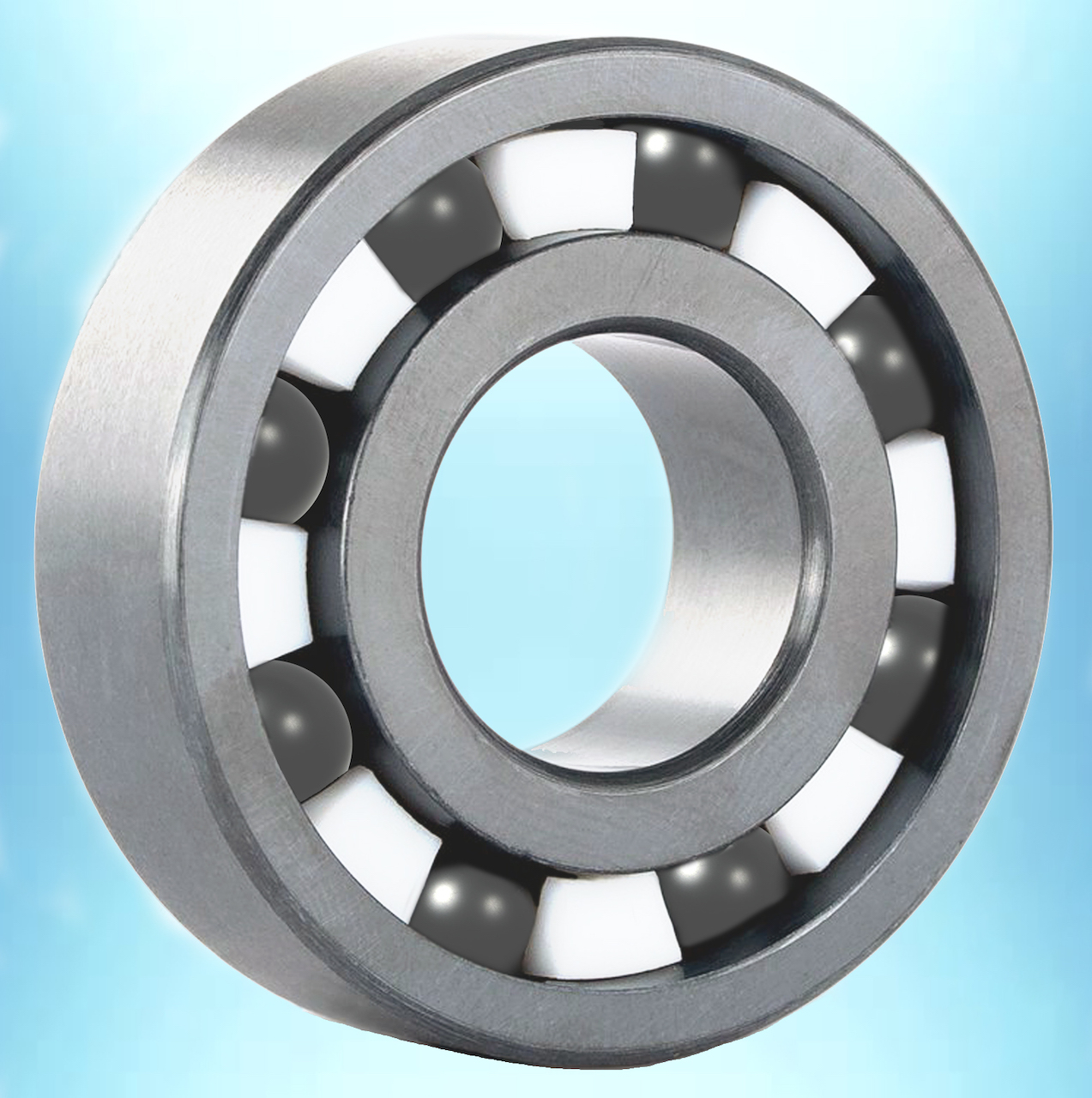We have come to the last installment of our in-depth examination of materials that are used to manufacture ball bearings, all of which can be implemented in a wide range of fields. We hope that the previous posts have enlightened you with insightful information to contemplate when presented with a variety of materials, and ultimately guide you on the path to making an informed decision of the best bearing material for your application. In this final AST blog installment, we will dive into ball bearings engineered from ceramic materials, and how their different properties can influence the selection process.
The following is Part 3 of a three-part post. You can read Part 2 here and Part 1 here.
Stainless steel rings, silicon nitride (Si3N4) ceramic balls, with plastic crown ball retainer.
 Bearings made of ceramic materials
Bearings made of ceramic materials
Bearings made with ceramic materials fall into a specialty niche in the bearing industry. The most common arrangement is a hybrid bearing, usually with stainless steel rings and ceramic balls. The most common ceramic material used is silicon nitride. Balls made from this material are hard, up to Rc78, and have a very smooth surface. Hybrid bearings are more expensive than all-stainless-steel bearings.
Today’s engineers have many options available to them when faced with extreme or demanding operating conditions. This abundance of choices includes the use of ceramic materials that have many benefits in a variety of applications. The most common use is producing the rolling elements — the balls — from a ceramic material with the inner and outer rings made from traditional, heat-treated, chrome, or stainless steel.
With improvements in manufacturing technology, Full Ceramic Bearings are also readily available. These bearings have both the inner and outer rings and the rolling elements manufactured from ceramic material. While hybrid and full ceramic bearings demand a premium price, they are often the most economical solution when considering the cost of a failure and the total cost of ownership for the end-user.
The most common configuration is with chrome or stainless steel rings and ceramic balls. Nitrogen-enhanced stainless steel ring material is also available.
The most common ceramic material for the balls is silicon nitride, Si3N4. Compared to traditional steel balls, this material has desirable properties for rolling bearings, such as:
- lightweight (approximately 60% lighter than bearing steel)
- high hardness — over 75 HRc
- higher elastic modulus — stiffer
- lower coefficient of thermal expansion
- higher maximum operating temperature — 10000C
- highly polished surface finish resulting in lower friction
Balls made of zirconia, ZrO2, are also available. This ceramic material has some properties similar to silicon nitride but differs in that it has some mechanical and thermal properties much closer to that of the alloy steel that the rings are made from. This can be desirable in maintaining the preload and contact angle over a broad range of operating temperatures.
Benefits of Hybrid Ceramic Bearings:
- higher stiffness and rigidity reduces deflection
- increased the limiting speed, RPM
- less adhesive wear, there is no cold welding
- better lubricant life
- lower noise levels and vibration
- no electrical arcing through the balls
Applications for Hybrid Ceramic Bearings:
- machine tool spindles
- pumps – submersible, fuel, vacuum
- dental drills
- optical scanners
- electric motors
- aerospace applications
- laboratory equipment
- applications that require higher speeds, longer life, and lower friction
Full Ceramic Bearings
Full Ceramic Bearings are often the answer for extreme environments, such as high temperatures, corrosive chemicals, steam, and hard vacuum. These bearings have both the inner and outer rings and the rolling elements manufactured from ceramic material. Like the balls in hybrid bearings, the rings in full ceramic bearings are typically manufactured from silicon nitride, Si3N4, or zirconia, ZrO2. Retainers in full ceramic bearings are usually made from high-performance plastics such as PEEK or PTFE.
Benefits of Full Ceramic Bearings:
- resistant to acid, salt and water, and blood
- non-magnetic
- lower coefficient of friction
- resistant to electricity
- corrosion-resistant
- lighter, smoother and stiffer
Applications for Full Ceramic Bearings:
- MRI equipment
- vacuum environments
- semiconductor manufacturing
- radiotherapy
- food processing industries
- any extreme environment requiring non-corrosive, non-conductive, or non-magnetic bearings
Summary
Selecting the right bearing material for your application requires more than just a basic understanding of its chemical composition. There are several basic choices and some variations within each category, so comparisons should be made amongst the features and benefits--as well as the advantages and disadvantages--of each option in order to understand how they will affect the final configuration. Employing this strategy will narrow down the field to the best choice for optimal performance and maximum operational life.

